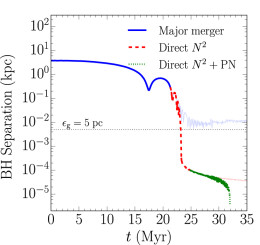When galaxies merge, the supermassive black holes (SMBHs) at the galaxies’ centers are thought to coalesce, forming a new, larger black hole. But can this merger process take place on timescales short enough that we could actually observe it? Results from a new simulation suggest that it can!
When Galaxies Collide

These stills demonstrate the time evolution of the galaxy merger after the beginning of the authors’ simulation (starting from z=3.6). The red and blue dots mark the positions of the SMBHs. [Adapted from Khan et al. 2016]
Why are these mergers poorly understood? Modeling them — from the initial interactions of the host galaxies all the way down to the final coalescence of their SMBHs in a burst of gravitational waves — is notoriously complicated, due to the enormous range of scales and different processes that must be accounted for.
But in a recent study, a team of scientists led by Fazeel Khan (Institute of Space Technology in Pakistan) has presented a simulation that successfully manages to track the entire merger — making it the first multi-scale simulation to model the complete evolution of an SMBH binary that forms within a cosmological galaxy merger.
Stages of a Simulation
Khan and collaborators tackled the challenges of this simulation by using a multi-tiered approach.
- Beginning with the output of a cosmological hydrodynamical simulation, the authors select a merger of two typical massive galaxies at z=3.6 and use this as the starting point for their simulation. They increase the resolution and add in two supermassive black holes, one at the center of each galaxy.
- They then continue to evolve the galaxies hydrodynamically, simulating the final stages of the galaxy merger.
- When the separation of the two SMBHs is small enough, the authors extract a spherical region of 5 kpc from around the pair and evolve this as an N-body simulation.
- Finally, the separation of the SMBHs becomes so small (<0.01 pc) that gravitational-wave emission is the dominant loss of energy driving the inspiral. The authors add post-Newtonian terms into the N-body simulation to account for this.

Time evolution of the separation between the SMBHs, beginning with the hydrodynamical simulation (blue), then transitioning to the direct N-body calculation (red), and ending with the introduction of post-Newtonian terms (green) to account for gravitational-wave emission. [Adapted from Khan et al. 2016]
Successful Coalescence
Khan and collaborators’ complex approach allows them to simulate the entire process of the merger and SMBH coalescence, resulting in several key determinations.
First, they demonstrate that the SMBHs can coalesce on timescales of only tens of Myr, which is roughly two orders of magnitude smaller than what was typically estimated before. They find that gas dissipation before the merger is instrumental in creating the conditions that allow for this rapid orbital decay.
The authors also demonstrate that the gravitational potential of the galaxy merger remnant is triaxial throughout the merger. Khan and collaborators’ simulations confirm that this non-spherical potential solves the final parsec problem by sending stars on plunging orbits around the SMBHs. These more distant stars cause the SMBHs to lose angular momentum through dynamical friction and continue their inspiral, even when the stars immediately surrounding the SMBHs have been depleted.
This simulation is an important step toward a better understanding of SMBH mergers. Its outcomes are especially promising for future gravitational-wave campaigns, as the short SMBH coalescence timescales indicate that these mergers could indeed be observable!
Citation
Fazeel Mahmood Khan et al 2016 ApJ 828 73. doi:10.3847/0004-637X/828/2/73

2 Comments
Pingback: SMBH mergers
Pingback: Simulando una fusión de objetos supermasivos « SEDA / LIADA